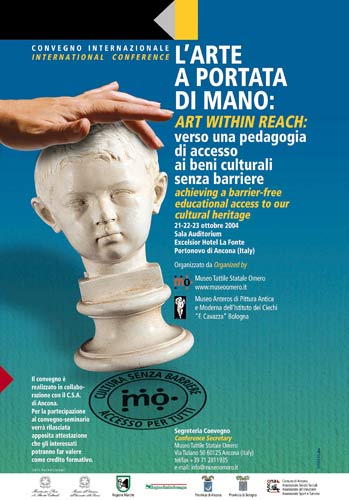Internacional Conference
Posted in Events on 1 October 2004

Sala Auditorium
Excelsior Hotel La Fonte
Portonovo (Ancona)
21-22-23 October 2004
Organization
Museo Tattile Statale Omero - Museo Tattile di Pittura antica e moderna "Anteros" dell'Istituto dei Ciechi F. Cavazza
With the aegis of
Ministero per i Beni e le Attività Culturali;
Ministero dell'Istruzione, dell'Università e della Ricerca;
Regione Emilia Romagna;
Regione Marche;
Provincia di Bologna;
Provincia di Ancona;
Comune di Ancona.
The long standing debate about access to culture, accessible museum pathways, integration of the visually handicapped into mainstream schools, the workplace and society in general, and hence about the effects of positive experiences, has led public and private Museums to examine the multiple psycho-rehabilitative functions of an aesthetic education.
A correct perception, cognition and interpretation of aesthetically rich images can induce structured and creative learning processes which play an important role in both the individual and collective formation of the person.
These are orientating processes in that they lead the person towards a targeted, conscious use of the senses but, first of all, they demand a rigorous investigation of the prerequisites of the starting point. As these processes are perfected, they lead to a strengthening of the cognitive faculties of those born blind, those who have become blind, the partially sighted and the fully sighted. All this generates abilities which are naturally convertible.
The subjects to be discussed at the conference have been chosen to contribute to our overall aim which is to create methods of teaching Art that can be used by the visually handicapped and the sighted of all ages and in diverse contexts.
Our starting points will be disciplines such as the physiology and phenomenology of vision, the psychology of optical and tactile perception, typhlology, aesthetics, pedagogy, theory and teaching of the arts and epistemology.
Museums and Institutes have long felt the need to adequately educate a heterogeneous public and user group who require methodologically efficacious proposals as well as adequate specific and/or unifying services, so that their knowledge of Art is not just extemporany experience but has the possibility of becoming a deeper knowledge of the roots of thought and the structure of visual language.
In order to understand the reasons that have lead to a general critical review of learning systems, mnemonic stratification, conservation and re-elaboration of the knowledge acquired by the non-sighted, partially sighted and fully sighted, we have to understand to what extent representational modes and their meaning are shared, from a perceptive and cognitive point of view as well as from an intellectual and reificative point of view.
The conference, which will be held in Ancona in October 2004, will present these themes prepare the ground for a fruitful interdisciplinary debate between the various experts whose fields of knowledge we consider to be complementary.
Afterwards we are going to publish a scientific paper which will describe the current situation in this field at both national and international level. It will also be a useful handbook for anyone working in art education in museums, art galleries, schools etc...
